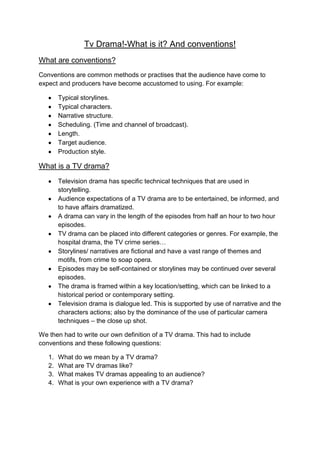
Tv drama
- 1. Tv Drama!-What is it? And conventions! What are conventions? Conventions are common methods or practises that the audience have come to expect and producers have become accustomed to using. For example: Typical storylines. Typical characters. Narrative structure. Scheduling. (Time and channel of broadcast). Length. Target audience. Production style. What is a TV drama? Television drama has specific technical techniques that are used in storytelling. Audience expectations of a TV drama are to be entertained, be informed, and to have affairs dramatized. A drama can vary in the length of the episodes from half an hour to two hour episodes. TV drama can be placed into different categories or genres. For example, the hospital drama, the TV crime series… Storylines/ narratives are fictional and have a vast range of themes and motifs, from crime to soap opera. Episodes may be self-contained or storylines may be continued over several episodes. The drama is framed within a key location/setting, which can be linked to a historical period or contemporary setting. Television drama is dialogue led. This is supported by use of narrative and the characters actions; also by the dominance of the use of particular camera techniques – the close up shot. We then had to write our own definition of a TV drama. This had to include conventions and these following questions: 1. What do we mean by a TV drama? 2. What are TV dramas like? 3. What makes TV dramas appealing to an audience? 4. What is your own experience with a TV drama?
- 2. So what is it? A TV drama is a show that runs in a series; it usually has a conclusion at the end of an episode then moves on. Episodes may be self-contained or storylines could be stretched out over a number of episodes. A conventional episode within a TV drama could be a murder mystery drama. The storyline could go as follows; a murder has taken place at the beginning of the episode, throughout the episode they progress to find suspect and clues, then they conclude the episode with they have found out who had done it, why they did it, and how they did it. TV dramas have specific technical techniques that are used in the storytelling. TV dramas can vary in time length from half an hour to two hours per episode, and could be on TV from 8 o clock or if more intense from 9 onwards, but usually the two hour long episodes start at 8 o clock. What makes a TV drama appealing to an audience is they don’t let too much go at once; they start with an intense beginning to grip their audience and keep letting little bits go to keep you engaged in the episode until the end where they conclude the episode until the end where they conclude the episode. An audience’s expectations of a TV drama is to therefore be entertained, informed and to have the affairs within the episode dramatized. TV drama is very much dialogue led. This is supported by the use of narrative and the character’s actions. Also by the dominance of the use of particular camera techniques – the close-up shot. We then watched a TV drama called Holby blue, we had to analyse it and it’s conventional characteristics. Holby Blue! Genre – Crime drama. Characters: Woman officer in charge: Not conventional, usually a man in charge, she seems strong and firm, which isn’t very womanly. Ironic that she says they are professional team when off duty officer isn’t very professional. Off duty police man: Conventional character. Family man, comical does the job in hand – even though not professionally, family problems- he’s divorced. Man with threatening behaviour: Conventional character, scruffy, unclean, threatening behaviour with a weapon, wont calm down, gets arrested, and not well spoken (speaks in a poor accent in slangish words). Setting: Conventional setting police station, holding a meeting. Camera keeps crossing from police station to a hospital. Very busy environment. Action: They start the episodes with a gripping opening before the title credits, this is to grip their audience in.
- 3. Graphics: Blues and blacks – dark colours suggest seriousness. Sound: Dramatic music under the action in the opener. Sirens going off suggests emergency, loud and busy noises.